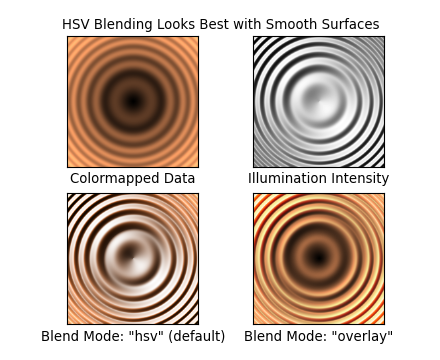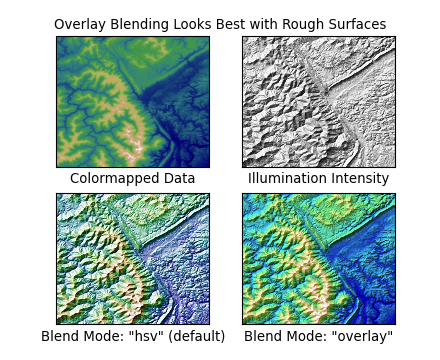


(png)

(png)
import numpy as np
import matplotlib.pyplot as plt
from matplotlib.colors import LightSource
from matplotlib.cbook import get_sample_data
# Example showing how to make shaded relief plots
# like Mathematica
# (http://reference.wolfram.com/mathematica/ref/ReliefPlot.html)
# or Generic Mapping Tools
# (http://gmt.soest.hawaii.edu/gmt/doc/gmt/html/GMT_Docs/node145.html)
def main():
# Test data
x, y = np.mgrid[-5:5:0.05, -5:5:0.05]
z = 5 * (np.sqrt(x**2 + y**2) + np.sin(x**2 + y**2))
filename = get_sample_data('jacksboro_fault_dem.npz', asfileobj=False)
with np.load(filename) as dem:
elev = dem['elevation']
fig = compare(z, plt.cm.copper)
fig.suptitle('HSV Blending Looks Best with Smooth Surfaces', y=0.95)
fig = compare(elev, plt.cm.gist_earth, ve=0.05)
fig.suptitle('Overlay Blending Looks Best with Rough Surfaces', y=0.95)
plt.show()
def compare(z, cmap, ve=1):
# Create subplots and hide ticks
fig, axes = plt.subplots(ncols=2, nrows=2)
for ax in axes.flat:
ax.set(xticks=[], yticks=[])
# Illuminate the scene from the northwest
ls = LightSource(azdeg=315, altdeg=45)
axes[0, 0].imshow(z, cmap=cmap)
axes[0, 0].set(xlabel='Colormapped Data')
axes[0, 1].imshow(ls.hillshade(z, vert_exag=ve), cmap='gray')
axes[0, 1].set(xlabel='Illumination Intensity')
rgb = ls.shade(z, cmap=cmap, vert_exag=ve, blend_mode='hsv')
axes[1, 0].imshow(rgb)
axes[1, 0].set(xlabel='Blend Mode: "hsv" (default)')
rgb = ls.shade(z, cmap=cmap, vert_exag=ve, blend_mode='overlay')
axes[1, 1].imshow(rgb)
axes[1, 1].set(xlabel='Blend Mode: "overlay"')
return fig
if __name__ == '__main__':
main()
Keywords: python, matplotlib, pylab, example, codex (see Search examples)